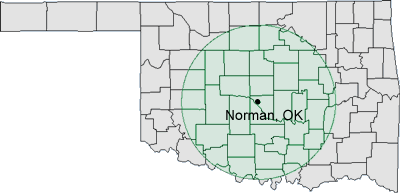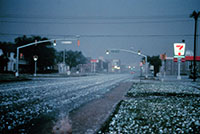Hail Size Discrimination Experiment (HaSDEx)
 |
Project Status: Active09/10/2008 through 09/14/2008 PM -- Heavy rain will continue through the weekend. Hail is very unlikely, but reports of rain, especially *very* heavy rain, are useful, so please send those in. Of course, if you see any hail, we'd like to know about it! !!!=====!!! Please note that because of computer security requirements, reports you make to the NWS are not shared with HaSDEx and reports to HaSDEx are not shared with the NWS, so please keep both in mind as you submit reports and observations. |
If you live within 90 miles of Norman, Oklahoma, we invite you to be a part of NSSL's science and research. We are looking for volunteers of any age and education level (including teachers, families, and classes) to observe and report hail size when hail occurs at your location during severe weather events. The project is called the Severe Hail Discrimination Experiment (HaSDEx), and follows on the heels of the very successful Winter Hydrometeor Classification Ground Truth Program.
 The project supports NSSL scientists involved in developing new radar technologies
and techniques to determine not only the presence of hail, but the size of
the hail falling at any given location. As a volunteer, you will provide valuable
information that will allow us to compare what you have observed with what
the radar has detected.
The project supports NSSL scientists involved in developing new radar technologies
and techniques to determine not only the presence of hail, but the size of
the hail falling at any given location. As a volunteer, you will provide valuable
information that will allow us to compare what you have observed with what
the radar has detected.
You can spend as little (or as much) time as you wish on making observations, because the basic idea is simple: NSSL will collect radar data during severe weather events within about 90 mi of Norman, Oklahoma, but we also need to know what has happened on the ground, where you live. Has hail occurred? If so, what was the maximum size you observed? Hail size data are particularly rare, and we need as much of it as possible. Storm chasers and emergency personnel are encouraged to record where and when they encounter hail.
Please note: While these data are important, safety is absolutely essential. Please read the safety tips here.
A complete observation consists of the date, time, maximum hail size, and the location of your observation. Make sure the time you report represents the time when hail was actually falling. The start and end times of the hail may be reported in the "comments" box. Locations should consist of an accurate latitude/longitude, which can be determined from your address. If you are not at a known address, you may enter an approximate location within the comment field, such as "5 1/4 mi south of state highway 39 on state highway 76."
If you have any questions, feel free to contact Dr. Kim Elmore by email at kim.elmore@noaa.gov or telephone at (405) 325-6295.
